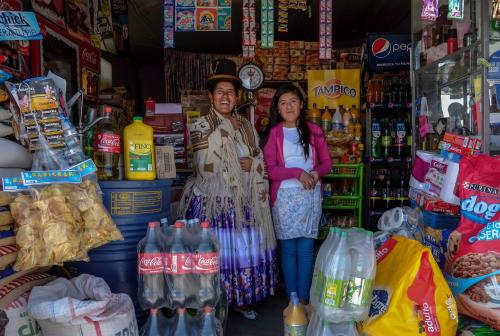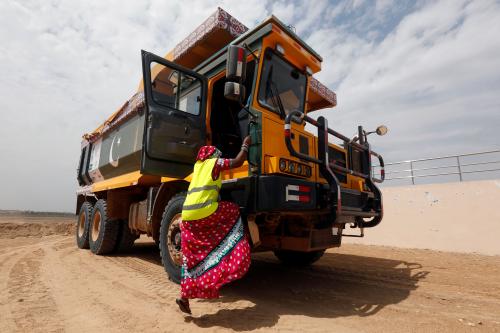This February, President Trump announced his new Women’s Global Development and Prosperity Initiative (W-GDP), a “whole-of-government” approach that aims to promote women’s economic empowerment (WEE) across the globe. Framed as a component of his National Security Strategy, W-GDP builds around three core pillars of intervention. The first pillar, “women prospering in the workforce,” advocates for workforce development, vocational and skills training to increase women’s labor force participation. The second, “women succeeding as entrepreneurs,” supports expanding access to capital, markets, and networks to help women grow their small businesses. The third pillar, “women enabled in the economy,” seeks to remove legal, regulatory and cultural barriers that inhibit women’s equal participation in the economy. The President also proposed the establishment of a $50 million fund within the U.S. Agency for International Development (USAID) to support new projects in line with the W-GDP agenda. The initiative aims to reach 500 million women by 2025.
The President’s new initiative is a positive step by the administration to promote WEE and gender equality, and largely aligns with what leading research suggests—that women’s economic participation and empowerment matter greatly for economic growth and poverty reduction.
Though the lives of women and girls in developing countries have improved dramatically in the last 50 years, women’s access to economic opportunities remains constrained. While women participate in the labor market more than ever before, gender gaps in earnings, productivity, and economic activity persist across all countries and levels of income (see Figure 1). As wageworkers, women concentrate in lower-paying sectors and occupations. As entrepreneurs, they lead smaller firms in less profitable sectors. As farmers, they work smaller plots and have lower yields. These gaps matter for economic growth; the McKinsey Global Institute estimates that full female participation and integration into the labor force could boost global GDP by as much as 26 percent.
Drivers of the gender gap
The existence and persistence of these gender gaps stems from three key factors: different use of time, different human capital, and discrimination. First, women devote more time to care and related household work than men, which limits the time they have available for paid work. This division of labor stems from deep-rooted social norms about the roles of women and men, which have proven remarkably resistant to change. Second, though gender disparities in school attainment have shrunk or even reverted in some countries, important differences remain in educational trajectories and the types of skills men and women acquire in school. These skills gaps are often the result of self-segregation into traditionally male and female fields of study, which, in the long run, makes it difficult for women to compete on a level playing field for higher paying jobs in high growth sectors. Third, markets and institutions often work in ways that treat women and men differently. In sectors with low female employment, employers may be reluctant to hire women based on biased beliefs about their qualifications, or fear of the additional “costs” that may come along with a female employee—such as maternity leave or absences due to child care. Discrimination in labor and credit markets and differential access to productive inputs also contribute to an unequal playing field.
While the W-GDP initiative announcement acknowledged most of these factors, it largely skirts around some of the more sticky elements that impede women’s labor force participation. The three pillars focus on human and physical capital needs, as well as hard skills training—inputs that are relatively easy to provide and core components of many development programs. On the other hand, the initiative fails to tackle some of the less visible barriers to WEE, such as soft skills gaps, social norms, informal institutions, and household dynamics. While it mentions the role that unpaid care work plays in limiting women’s economic participation, none of the pillars include a clear call for policies or programs to reduce this constraint—arguably the largest obstacle for most women in the developing world (see Figure 2).
Pillar Two highlights how women’s lack of access to markets, information, and networks inhibits the success of their businesses. Yet it largely treats these access issues as individual constraints, downplaying the way institutional structures and social norms systematically restrict women’s active participation in the labor force. Studies find that while finance and business training increase the profitability of male entrepreneurs, these inputs alone do not create similar gains for females. Women face different market barriers due to sociocultural factors—female entrepreneurs, for instance, are often more risk averse than their male counterparts, and may lack soft skills more often cultivated in boys, such as leadership. These more nebulous attitudinal and cultural barriers to WEE are harder to tackle, as there are less clear policy prescriptions. Yet failing to address them means that W-GDP’s impact on WEE will be limited at best.
Figure 2. Barriers to women’s labor force participation
Source: Gallup Inc. and ILO (2017)
Building an evidence base
While the W-GDP approach does not address the full range of policy and programming responses necessary to support WEE, it does address a core need: building up an evidence base about what works. In the announcement, President Trump called for the establishment of clear metrics to define what successful WEE looks like, and the evaluation of current U.S. government programming. This will be challenging, as there has been relatively little progress on WEE, and the evidence on many types of interventions is mixed. A recent review of women’s entrepreneurship interventions finds that while loan and business training programs did not increase the profitability of female-owned businesses in Uganda and Tanzania, a similar training initiative in Nicaragua led to large increases in women’s income. The evidence around microfinance, once believed to be the panacea to global poverty and a core tool to promote female small and medium enterprise growth, is also largely mixed; some studies find no differential effects between male and female borrowers, while others find men reap larger gains. Another report found that strengthening land rights, providing extension services, and facilitating access to markets all have clear positive impacts on female farmer productivity. Yet the evidence is mixed on other common interventions, such as improving the use of new seed varieties, providing community-based childcare, and promoting high-value crop cultivation. Researchers find that economic empowerment interventions need to do more than provide access to skills and inputs—they need to shift women’s consciousness and mindset, and challenge sociocultural norms. Building up an evidence base around what works may arguably be W-GDP’s largest contribution to the WEE agenda.
Promoting greater gender equality matters intrinsically, but it is also sound economic policy. Reallocating female labor to more productive uses will enhance overall economic output, GDP growth, and household-level well-being. A forthcoming paper finds that in more gender equal countries, industries with high female employment grow faster than industries with low female employment, suggesting that gender equality provides an enabling environment for economic growth. Women’s labor force participation matters for countries at all levels of development, but the impact in developing countries, where the productivity and opportunity gaps between men and women are particularly large, is substantial. The W-GDP initiative is a welcome reprioritization of the importance of WEE in the U.S. development agenda, creating shared direction and allocating additional (albeit small) resources towards the issue. However, supporting WEE is not just about increasing access to finance and providing hard skills training; progress also depends on addressing the larger informal, institutional, and social norms that inhibit women’s full participation in the economy.
The Brookings Institution is committed to quality, independence, and impact.
We are supported by a diverse array of funders. In line with our values and policies, each Brookings publication represents the sole views of its author(s).









Commentary
The Women’s Global Development and Prosperity Initiative: Will it work?
March 7, 2019